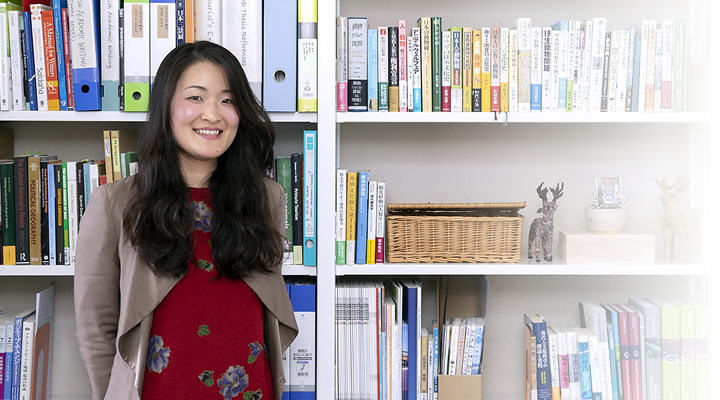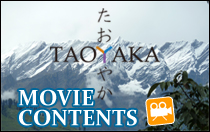
INTERVIEW
A geographical study of human-animal relationships
with a focus on tourism destinations
Searching for the seeds of
on-site reverse innovation
in the field of animal geography
Hijiyama University
Faculty of Contemporary Culture
Department of Mass Communication
Lecturer Rie Usui
A geographical study of human-animal relationships
with a focus on tourism destinations
The future prospects of wildlife tourism in Japan

Dr. Usui specializes in animal geography, which may sound unfamiliar to many people.
“In my case, I study the relationships between humans and animals from a geographical standpoint (New Animal Geography). In particular, I have been conducting my research at tourist sites and looking at the relationships between humans and animals by observing the way animals are managed and examining how tourists view animals,” she said. “One characteristic of New Animal Geography is to treat animals as an active agency. In other words, animals are not objects or resources to be simply utilized but they are individuals with their own will. Therefore, animal geographers are typically critical of anthropocentric thinking, and are interested in exploring how human society can advance to give moral consideration toward animals if we are to coexist with them.” she explained.

Her current research site is “Ōkunoshima Island” also known as Rabbit Island, located in the Seto Inland Sea. The island, now known worldwide, has been experiencing adverse effects from overtourism and was recently featured on TV programs.
“The number of tourists who visit Ōkunoshima Island has increased rapidly over the last few years. Many tourists bring rabbit food to the island, which has resulted in a proliferation of rabbit population. By nature, rabbits in the wild are territorial. They can be violent to one another if the population density becomes high, and injuries caused by the inter-species competitions are observed. Despite the current situation, there is no official management entity. Consequently, a variety of problems have arisen. For example, the excess food that tourists brought to the island is left as garbage and some rabbits have become sick.”
Dr. Usui is conducting research to understand the current state of this island to help establish a better relationship between humans and rabbits.
The first experience as a program mentor: Giving advice to students based on her own experience

Dr. Usui is in charge of three courses in the Taoyaka Program: “Creation of Regional Culture”, “On-site Training” and “On-site Course Rotation”.
In the “Creation of Regional Culture,” her students discuss what regional culture is and why it is important for community revitalization. In this class, the students also learn the method of fieldwork through visiting the nearby community.
This year’s “On-site Training” was held in the Mitarai District, Kure City in August for four days. “On-site Course Rotation” involves the first-year students visiting a community for one day, which is followed by several weeks of group work and discussions. This year, Dr. Usui brought her students to Ōkunoshima Island and Tadanoumi in Takehara City.
Although Dr. Usui participated in the Taoyaka Program as a mentor for the first time this year, she once was a student in the program. She is an alumni completed the Taoyaka Program in March 2019. Mitarai is a place where she carried out her on-site team project.

“When I was conducting my project, I encountered the question as to what reverse innovations should look like. There was no concrete set of approach to follow.”
Based on her experience, she is trying to incorporate materials that she feels Taoyaka students should know into her class.
“In addition to the basic interview method, I share a particular communication skill called, “meta-facilitation,” which facilitates learning and encourages behavioral changes in each individual through simple dialogues.” she said.
“This is the technique that my teacher introduced to me when I was a student, and I really want Taoyaka students to master this technique.”
Linking class materials with community interests. Keeping prior information minimum

Her classes consist of the following three main features.
The first is “practicality.” Normally, the classes mainly consist of classroom lectures, but she gives students a specific theme, “Problem-Solving in Higashi-Hiroshima City” to encourage them to link the knowledge they learn in class with the real life situation, and have discussions based on what they experienced.
“This year, I try to combine class assignments with ‘Research Prize Essay Contest Related to Problems in the Local Community’ offered by Higashi-Hiroshima City as a project for my students. Ultimately, I encourage students to submit their work.”
The second is “keeping prior information to a minimum.” The aim is to give students participating in the on-site course rotation without having presumption about a community. She wishes students to “analyze the situation of the local community with their own eyes.”
The third is “emphasis on discussions.”
When she was asked about what she has gained from the Taoyaka Program, she smiled and said, “All the experiences that I had in the program have broadened my perspective greatly.”
“Conducting the on-site team project was not easy, but I was able to discuss issues after gaining insight of the whole picture because of my experience in the Taoyaka Program. I think it had a very positive impact on me.”

“It was also a good opportunity to think about what reverse innovation really means,” she said and passed on the following words of advice to her students, in hope that they will find a meaningful experience through this program.
“I think many students are eager to make ‘regional contributions’ like me, but in reality, it rarely happens in a short time period, and they may feel a sense of powerlessness. Instead, I want them to think this way. What they can do and try to do is to look for “seeds” that are suited for the condition of a local community. What happens after that, whether they plant the seeds and grow them, is up to the local residents. This is, of course, a collaborative effort with local residents. With that in mind, you will find what you need to do in the community.”
![]()
Rie Usui, Lecturer
Hijiyama University, Faculty of Contemporary Culture
Department of Mass Communication
2015/10/01 Enrolled in Graduate School of Integrated Arts and Sciences, Hiroshima University
2016/04 Enrolled as a student in the Taoyaka Program
2019/03 Received a doctoral degree from Graduate School of Integrated Arts and Sciences, Hiroshima University
2019/04/01 – 2019/04/30 Specially-appointed Assistant Professor, Graduate School of Letters, Hiroshima University
2019/05/01 – 2020/03/31 Assistant Professor, Graduate School of Letters, Hiroshima University
2020/04/01 – Assistant Professor, Graduate School of Humanities and Social Sciences, Hiroshima University
2021/10/01 – Lecturer, Hijiyama University, Faculty of Contemporary Culture, Department of Mass Communication





